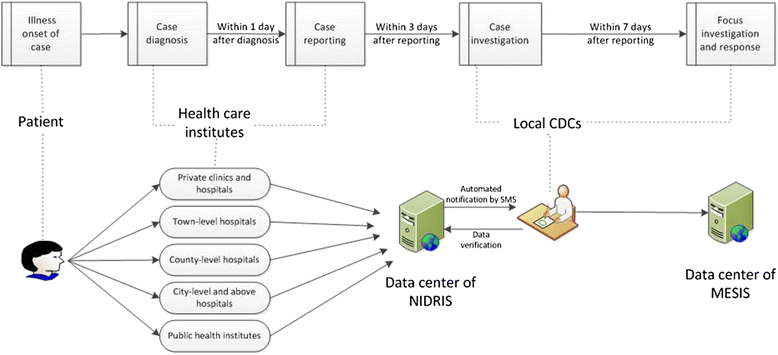Comparative evaluation of the diagnosis, reporting and investigation of malaria cases in China, 2005-2014: transition from control to elimination for the national malaria programme
- PMID: 27349745
- PMCID: PMC4924285
- DOI: 10.1186/s40249-016-0163-4
Comparative evaluation of the diagnosis, reporting and investigation of malaria cases in China, 2005-2014: transition from control to elimination for the national malaria programme
Erratum in
-
Erratum to: Comparative evaluation of the diagnosis, reporting and investigation of malaria cases in China, 2005-2014: transition from control to elimination for the national malaria programme.Infect Dis Poverty. 2017 Jun 19;6(1):111. doi: 10.1186/s40249-017-0317-z. Infect Dis Poverty. 2017. PMID: 28629405 Free PMC article. No abstract available.
Abstract
Background: The elimination of malaria requires high-quality surveillance data to enable rapid detection and response to individual cases. Evaluation of the performance of a national malaria surveillance system could identify shortcomings which, if addressed, will improve the surveillance program for malaria elimination.
Methods: Case-level data for the period 2005-2014 were extracted from the China National Notifiable Infectious Disease Reporting Information System and Malaria Enhanced Surveillance Information System. The occurrence of cases, accuracy and timeliness of case diagnosis, reporting and investigation, were assessed and compared between the malaria control stage (2005-2010) and elimination stage (2011-2014) in mainland China.
Results: A total of 210 730 malaria cases were reported in mainland China in 2005-2014. The average annual incidence declined dramatically from 2.5 per 100 000 people at the control stage to 0.2 per 100 000 at the elimination stage, but the proportion of migrant cases increased from 9.8 % to 41.0 %. Since the initiation of the National Malaria Elimination Programme in 2010, the overall proportion of cases diagnosed by laboratory testing consistently improved, with the highest of 99.0 % in 2014. However, this proportion was significantly lower in non-endemic provinces (79.0 %) than that in endemic provinces (91.4 %) during 2011-2014. The median interval from illness onset to diagnosis was 3 days at the elimination stage, with one day earlier than that at the control stage. Since 2011, more than 99 % cases were reported within 1 day after being diagnosed, while the proportion of cases that were reported within one day after diagnosis was lowest in Tibet (37.5 %). The predominant source of cases reporting shifted from town-level hospitals at the control stage (67.9 % cases) to city-level hospitals and public health institutes at the eliminate stage (69.4 % cases). The proportion of investigation within 3 days after case reporting has improved, from 74.6 % in 2010 to 98.5 % in 2014.
Conclusions: The individual case-based malaria surveillance system in China operated well during the malaria elimination stage. This ensured that malaria cases could be diagnosed, reported and timely investigated at local level. However, domestic migrants and overseas populations, as well as cases in the historically malarial non-endemic areas and hard-to-reach area are new challenges in the surveillance for malaria elimination.
Keywords: China; Elimination; Evaluation; Malaria; Surveillance.
Figures




Similar articles
-
Shrinking the malaria map in China: measuring the progress of the National Malaria Elimination Programme.Infect Dis Poverty. 2016 May 19;5(1):52. doi: 10.1186/s40249-016-0146-5. Infect Dis Poverty. 2016. PMID: 27197517 Free PMC article.
-
[Comparison of demographical characteristics of malaria cases from malaria control to elimination in China].Zhonghua Yu Fang Yi Xue Za Zhi. 2016 Apr;50(4):296-301. doi: 10.3760/cma.j.issn.0253-9624.2016.04.003. Zhonghua Yu Fang Yi Xue Za Zhi. 2016. PMID: 27029358 Chinese.
-
[Malaria situation in the People's Republic of China in 2011].Zhongguo Ji Sheng Chong Xue Yu Ji Sheng Chong Bing Za Zhi. 2012 Dec 30;30(6):419-22. Zhongguo Ji Sheng Chong Xue Yu Ji Sheng Chong Bing Za Zhi. 2012. PMID: 23484249 Chinese.
-
Surveillance and response to drive the national malaria elimination program.Adv Parasitol. 2014;86:81-108. doi: 10.1016/B978-0-12-800869-0.00004-4. Adv Parasitol. 2014. PMID: 25476882 Review.
-
Ready for malaria elimination: zero indigenous case reported in the People's Republic of China.Malar J. 2018 Aug 29;17(1):315. doi: 10.1186/s12936-018-2444-9. Malar J. 2018. PMID: 30157876 Free PMC article. Review.
Cited by
-
Erratum to: Comparative evaluation of the diagnosis, reporting and investigation of malaria cases in China, 2005-2014: transition from control to elimination for the national malaria programme.Infect Dis Poverty. 2017 Jun 19;6(1):111. doi: 10.1186/s40249-017-0317-z. Infect Dis Poverty. 2017. PMID: 28629405 Free PMC article. No abstract available.
-
Improving local health workers' knowledge of malaria in the elimination phase-determinants and strategies: a cross-sectional study in rural China.Malar J. 2017 May 19;16(1):210. doi: 10.1186/s12936-017-1865-1. Malar J. 2017. PMID: 28526083 Free PMC article.
-
Epidemiological characteristics of malaria from control to elimination in Hubei Province, China, 2005-2016.Malar J. 2018 Feb 15;17(1):81. doi: 10.1186/s12936-018-2207-7. Malar J. 2018. PMID: 29448927 Free PMC article.
-
Evaluating the implementation of rapid diagnostic tests in a malaria elimination setting.Infect Dis Poverty. 2020 Jul 8;9(1):84. doi: 10.1186/s40249-020-00702-6. Infect Dis Poverty. 2020. PMID: 32641123 Free PMC article.
-
Mobile population dynamics and malaria vulnerability: a modelling study in the China-Myanmar border region of Yunnan Province, China.Infect Dis Poverty. 2018 Apr 29;7(1):36. doi: 10.1186/s40249-018-0423-6. Infect Dis Poverty. 2018. PMID: 29704895 Free PMC article.
References
-
- WHO . World Malaria Report 2015. Geneva: WHO Press; 2015.
-
- WHO. From malaria control to malaria elimination: a manual for elimination scenario planning. Geneva: WHO Press; 2014.
Publication types
MeSH terms
LinkOut - more resources
Full Text Sources
Other Literature Sources
Medical

